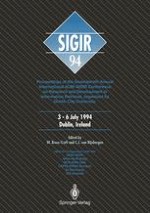Information retrieval (IR) is becoming an increasingly important area as scientific, business and government organisations take up the notion of "information superhighways" and make available their full text databases for searching. Containing a selection of 35 papers taken from the 17th Annual SIGIR Conference held in Dublin, Ireland in July 1994, the book addresses basic research and provides an evaluation of information retrieval techniques in applications. Topics covered include text categorisation, indexing, user modelling, IR theory and logic, natural language processing, statistical and probabilistic models of information retrieval systems, routing, passage retrieval, and implementation issues.
